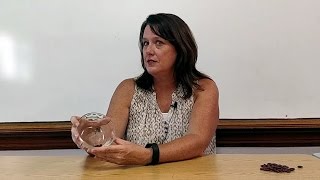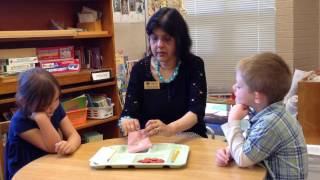Addition: “Counting On” Strategy
Janet Houk | Minneha Elementary | Wichita, Kansas
An addition lesson where the teacher uses dot cards to teach the children how to “count on” from any given number. The teacher counts each dot on the cards individually with the student so they can see how the process works. The students identify the card with the most dots and use it to “count on” to reach the total number for both cards.
Read Transcript
This is one way that I teach the strategy, “counting on” using dot cards with my students. I would get two cards these particular cards and hold them up in front of the children. See there’s two cards. Okay, and I’d have the class and I would count together the dots on the two cards. One, two, three, four, five, six, seven, eight. Then, I would ask them, boys and girls how many dots are on the two cards? And, they would hopefully tell me eight. If they tell me something different than I would count the cards again until they agreed as a group, there are eight dots on these two cards. And, I would say, gosh I wonder if there’s a faster way to count the dots on these cards? And, they might give me some ideas, and different things that they think would be there, and then I would tell them we’re going to learn the strategy of “counting on.” All right boys and girls how many dots are on this card? And then we would count them, one, two, three, four, five. How many dots five. Excellent boys and girls, how many dots are on this card? One, two, three. How many dots on this card. Three. Okay, now which card has the most dots? Hopefully, they would see that the five has more dots than the three. So, we would take five, and put it in our head. We’re going to hold the five in our head, boys and girls don’t forget it. What numbers in your head? Five. And then, we’re going to start with five, and count on. Five, six, seven, eight. Boys and girls, how many dots are on the two cards? Eight. That is right. Let’s try that strategy again. Boys and girls, here are two more cards. Okay, let’s count the dots. One, two, three, four, five, six. Can we count that faster? Can we do that job any quicker? Hopefully, they’re going to say we could count on. If they do not, then I would say remember we can count on. Which card has the most dots? One, two, three, four. I’m going to put these dots in my head, four. Remember, don’t lose it. What’s in your head? Four, and I’m going start with four and count on. Five, six. How many dots from both cards boys and girls? Six. Then we’re going to move on to two more cards. We’re going to do the same process, but this time I might have them do more of the work. Boys and girls, which card do we start with? Hmm, which card has the most dots? Hopefully, they noticed this one, and then we would count it. One, two, three, four, five, six. And, put that number in our head. What numbers in our head? Six. Start there, six, seven, eight, nine, ten. How many dots are on the cards boys and girls? Ten. The strategy is “counting on” and it’s quicker than counting dot by dot. I would continue this until every student was confident. If they just weren’t, I would take cards like this and put them in a bag and do small group activities. And, to build their confidence. If you have no cards, you can also use dice they work the same way and count the dots. This is one way that I would teach the strategy “counting on” to my early childhood students.
Help teachers and children
worldwide by sharing how
you teach.
A global movement of people sharing knowledge and learning from each other, to better educate our children and create hope for the world.
A global movement of people sharing knowledge and learning from each other, to better educate our children and create hope for the world.






